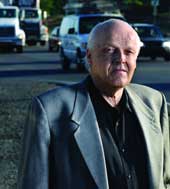In the summer of 2004, the General Services Administration's regional center in Boston was closed for nearly a week. GSA officials couldn't blame the shutdown on anthrax, bird flu or terrorists.They had no one to blame but Sen. John Kerry (D-Mass.).The Democratic National Convention was held in the building next door, and the Secret Service had declared the convention a national security event. Every federal employee who worked at the center was required to work somewhere else that week.Fortunately, the GSA center had been developing a telework plan since 1999. The Desktop 2000 plan is centered on a virtual connection from Citrix Systems. With Citrix MetaFrame installed in the office's data center, GSA employees can launch applications via the Web. Every user ' at every level ' is issued a laptop PC.[IMGCAP(1)]Because the center had prepared for the prospect of every employee working off-site, the office got through convention week with no downtime. Today a majority of employees telework, even with no emergency, and anyone who needs or wants to telework can, said Jim LeVerso, GSA's New England regional information technology manager.But few other agencies share GSA's enthusiasm for the virtual worker. According to a March study by CDW-Government, more than half of federal employees are eligible to telework, compared with fewer than 16 percent of those in the private sector. Yet not many avail themselves of the opportunity. Last month, the Office of Personnel Management reported to Congress that only 9.5 percent of the 1.2 million employees eligible to telework do so at least once a month.But the whole idea that an employee has to report to a specific geographic location to perform work is completely changing, thanks to technology. After all, as Nigel Ballard, government marketing manager at Intel said, 'Work is something you do, not someplace you go.'One morning, a government employee turns on CNN as she's taking a last sip of coffee before heading to work. She sees police wrapping hazmat tape around an office building that looks vaguely familiar. Then she realizes it's her office.If her agency has a telework plan in place, she can fire up her laptop and work from home, missing nary a beat, Ballard said.Telework can cut rush-hour traffic congestion in major cities. It can improve workers' morale. It can help the environment. But perhaps one of the best arguments for telework is that ' as GSA found ' it is essential for continuity-of-operations planning.'Back then, we were just talking about working off-site,' LeVerso said of Desktop 2000. 'The heart and soul of the solution revolved around the concept of teleworking and had no real bearing on our fledgling COOP program at that time.'Yet the ability to work remotely became the cornerstone of the center's disaster response plan. 'We learned very early on that COOP is telework,' LeVerso said.COOP plans are necessary even if the Big One never comes. All it took, for example, to bring the nation's capital to its knees for two days in March 2003 was an angry tobacco farmer and a tractor. Dwight Watson, a farmer from North Carolina, drove a tractor into a shallow pool near the Vietnam Veterans Memorial.Washington's usual traffic crawl became a nightmare as police tried to come to a peaceful resolution with Watson, who claimed to have explosives, although none were ever found.So why the reluctance to telework? Some say it's the lack of technology, and others say it is the lack of progressive thinking on the part of management or even the employees themselves.Certainly technology ' or lack of the latest technology ' does play a crucial role. Agencies haven't yet adopted the technologies that would make telework as effective as showing up every day at the office, the argument goes.[IMGCAP(2)]That is the position of the Telework Consortium, a nonprofit group established in 2002 under a grant from the National Institute of Standards and Technology.'We realized that unless telecommunications and computer technologies could support it, teleworking wouldn't happen,' said Bill Mularie, chief executive officer of the consortium.When Mularie began studying telework and why it's not more popular, the dominant view ' expressed by OPM and others ' was that it was all management's fault. 'Not true,' Mularie said. 'If technology doesn't allow you to call a meeting at a moment's notice ' or create a sort of water cooler effect ' it's not replicating the work environment.'Lack of good home Internet connectivity also can hamper telework. In a recent study of 30 developed countries, the U.S. ranked 15th in the percentage of homes with broadband connections to the Internet. 'And we're slipping,' Mularie said.Another bump in the road to telework for all eligible federal workers is the fear that computer troubles will slow teleworkers. Certain elements of office life can be replicated in a telework scenario. Instant messaging can replace co-worker banter; videoconferencing can supply a sense of face-to-face contact. But where's the help-desk guy when your laptop crashes?Johnathon Cervelli, product marketing manager at Blue Coat Systems, also sees technology as the main impediment to greater use of telework by feds.'You would think once you had [virtual private network] connectivity, you're good to go,' Cervelli said. But that's not always the case. 'A lot of applications use protocols that respond very badly to the kind of latency we find in long-distance networks.' This latency can slow network performance to the point where it could take a few minutes to open a file. 'That makes it hard to have a collaborative experience.'Still, personal perception ' at both the management and employee levels ' plays a role in the sluggish adoption of telework. The major roadblock is fear of the unknown, said Joel Brunson, president of Tandberg Federal. 'If you can't see an employee, are they really working?'According to the latest OPM telework survey, available at www.telework.gov, there's still too much of an 'if you're not in the office, you're not working' mentality: About 54 percent of federal employees surveyed identified organizational culture as the greatest barrier.Management wants the same productivity from teleworkers as if they were working in the office. And is that so wrong?Managers need to be educated about the value of telework, said Pierre Monacelli, senior vice president of project management leadership at Robbins-Gioia. They need to treat it with more seriousness. 'It's not just setting up somebody at home with a laptop,' he said. Managers with strong management skills usually don't have a problem with telework, Monacelli said.Too often, management fears a loss of control when employees telework. Many managers still have the 'mind-set of a 1950s movie, where the manager is looking out at a sea of people sitting at typewriters,' all under his scrutiny, Ballard said.Managers are going to have to be completely re-educated, said Bobby Caudill, group manager of global government solutions at Adobe Systems. They will have to move away from the management-by-wandering-around style to a pay-for-performance model.Even employees can fear teleworking. Some people shun telework because they fear a loss of banter and camaraderie with colleagues ' although perhaps an equal number welcome freedom from distracting office chatter.But with the right technology ' instant messaging, cell phones, e-mail, even videoconferencing equipment ' people can stay connected. 'You can still bridge that same sort of workplace environment,' he said. 'People are afraid [that] if they don't go into the office every day, they'll lose out somehow.'Telework is not for everyone, Mularie said. Nonetheless, he insists that many fears about telework tend to be unjustified. 'This thing we call the workplace is left over from the Industrial Revolution and the assembly line.'Despite the many obstacles, some agencies such as the Food and Drug Administration have embraced the concept of telework.[IMGCAP(3)] Since the 1990s, FDA has moved toward a greater use of telework as the technology has evolved, said Ginger Leo, FDA's acting deputy chief information officer. The agency supplies teleworkers with laptops to work from home or at satellite offices.As a result, telework has become a way of life for many agency employees, Leo said. It's one of the ways the agency helps employees balance work and family, and it has become one of FDA's recruitment tools, she said.FDA has developed a one-stop IT shop that can also function as a remote help desk. The Employee Resource and Information Center is on duty to answer employee help-desk calls at the office, at home or on the road via phone or e-mail.And because security is a concern whenever government equipment ' especially laptops that can cost $1,500 or so ' are taken off-site, FDA uses tokens, passwords, encryption and other network security measures to keep track of its hardware.Leo's own experience as a teleworker has been positive. 'When I participated, I found it easier to not have the interruptions of the office,' she said. 'I could focus on my specific task, to review a lot of proposals. I could think alone without having people stopping by.'XXXSPLITXXX-As the number of teleworkers grows, feds are taking advantage of some videoconferencing and network technologies to help make the commute from the bed to the laptop PC in the den a little easier.The Food and Drug Administration, for example, implemented a Cisco Systems collaboration suite for 10,000 researchers and scientists. They can access a secure virtual private network using a Cisco suite that includes unified messaging and voice over IP.Cisco representatives say collaborative technology can keep important work relationships viable in a telecommuting environment. Telework will expand through tools such as Cisco's TelePresence, which uses high-definition video technology, said Bruce Klein, vice president at Cisco Federal.'You'll feel like you're sitting in the same room with someone, even though he's in Hong Kong,' said Chris Shenefiel, industry solution manager at Cisco's worldwide federal government division. The oft-cited wish of managers to be able to see their teleworking employees is now possible, albeit at a considerable price.Telework and continuity of operations really do go hand-in-hand, said Greg McDermott, director of federal initiatives at Marathon Technologies. Telework and COOP policies are 'not just for when the Big One comes, but we also need to be ready for simple displacing events.''Government has done a great job of protecting essential systems from a major disaster such as Hurricane Katrina,' said Steve Keilen, Marathon's marketing director. 'But no one has cracked the code on the things that really cause outages on a day-to-day basis. And these things need to be considered in a COOP plan.'Marathon's everRun software is used in federal applications that require a high-availability architecture and 100 percent redundancy, such as aviation systems.EverRun synchronizes two standard Windows servers. The software creates a single Windows environment that operates like a stand-alone server. 'If there's a disk drive that fails or reaches over-capacity, the system will continue to operate with no disruption of service,' Keilen said.EverRun also is part of a congressional threat alert system. Congressional leaders have buttons under their desk that they can push if they feel threatened, McDermott said.To enable more telework, some agencies, including the Internal Revenue Service and the Homeland Security Department, are adopting a 90/10 work paradigm, said Nigel Ballard, government marketing manager at Intel. Ninety percent of employees receive laptops, 10 percent get desktops.The days when an agency had backup systems in a locked room off-site are over, Ballard said. Nobody ever checks on the room, 'the batteries go flat and nobody remembers the passwords.' Better to have a highly mobile workforce equipped with laptops that contain robust security features.Teleworkers should be able to have the same experience they have at the office, whether they are working from home, a hotel room or a satellite center, said Tom Simmons, federal area vice president at Citrix Systems.General Services Administration employees access their network using Citrix Presentation Server every workday, Simmons said. If an event triggers the agency's COOP plan, and users have to connect from home, there's no spike in license demand.Users can get to their data from anywhere they have access to a remote connection. 'All I need is a keyboard, a monitor and a dial-up connection, and I can log in to any application,' Simmons said.Government has little choice but to embrace telework, Simmons said. The generation coming into the federal workforce posted their college papers online and checked class schedules and assignments on Web sites. 'Their whole world is an on-demand thing,' he said. 'They access the Internet at Starbucks and on the beach.'Bobby Caudill, group manger for global government solutions at Adobe, thinks part of government's lack of mobility is its addiction to paper.Caudill uses the example of a travel request. 'That's been done in paper and pencil for years.' But by extending that document online and eliminating the paper, the whole geography of the process changes. No need to traipse back to the office to get a supervisor's signature. 'Once you've eliminated paper, you've made your environment friendly to teleworkers.'Removed from the umbilical cord of the help desk, some teleworkers fear they will encounter computer problems that they won't be able to handle.Adobe's Connect Web communication tool is one solution to this, Caudill said. Connect lets a help-desk employee take over someone's desktop remotely. Face-to-face meetings over Connect reduce the sense of isolation some employees might feel.Videoconferencing and online collaboration tools are the keys to pulling government through a COOP event, Caudill said. 'In the case of a pandemic flu, the last thing you want to do is bring everybody together.'XXXSPLITXXX-Last month, the Office of Personnel Management released its annual report to Congress on the status of telework in the federal government (to read the full report, go to GCN.com/809).Fifty-two agencies, covering 1,802,032 employees, responded to OPM's survey. Of that total, 1,253,509 are eligible to telework, and 119,248 telework at least one day a month. That's 9.5 percent of the number of eligible workers; 6.6 percent of the total population covered in the survey. The survey included some very small agencies ' such as the Japan-U.S. Friendship Commission, with a total population of four. The list below covers agencies with at least 1,000 employees eligible for teleworking.
AT HOME: 'We learned very early on that COOP is telework,' said Jim LeVerso, a manager at the General Services Administration's Boston office.
WPN Photo by Bryce Vickmark
If technology doesn't allow you to call a meeting at a moment's notice ' or create a sort of watercooler effect ' it's not replicating the work environment. ' Bill Mularie, Telework Consortium
GCN Photo by Zaid Hamid
GOOD WORK: Ginger Leo, FDA's acting deputy chief information officer, enjoyed not having the interruptions at the office.
GCN Photo by Rick Steele
Top Five
| Agency |
Eligible
Employees | % of Eligible
Teleworking |
| EEOC |
1,838 |
41.6 |
| Commerce |
33,689 |
34.1 |
| Education |
4,282 |
33.4 |
| SEC |
3,820 |
28.7 |
| SSA |
16,103 |
24.3 |
Bottom Five
| Agency |
Eligible
Employees | % of Eligible
Teleworking |
| FTC |
1,200 |
1.7 |
Homeland
Security | 50,999 |
1.9 |
| SBA |
6,087 |
2.2 |
| Justice |
61,932 |
2.9 |
| Energy |
12,002 |
3.3 |









